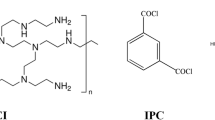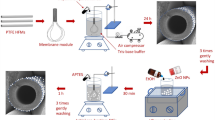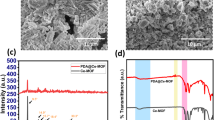Abstract
The presence of microorganisms on filtration membranes can cause biofouling phenomena. In this study, poly(ether sulfone)- (PES)-based functional ultrafiltration membranes were developed by employing chitosan (CS) and ammonium chloride (NH4Cl) as antibacterial agents to enhance antibiofouling properties. A PES membrane was prepared using the phase inversion method and then immersed in CS/NH4Cl solutions containing different NH4Cl concentrations to form composite membranes. The membrane antibiofouling properties were evaluated using Kirby Bauer and total plate counting methods. The structures and properties of the composite membranes were characterized by FTIR spectroscopy, SEM-EDX, porosity and hydrophilicity measurements, and tensile tests. The addition of NH4Cl increased the antibiofouling properties of the membranes, where maximum bacteria-killing ratio (%BKR) values of 99.2 and 83.3% were observed against Staphylococcus aureus and Escherichia coli, respectively. The addition of CS/NH4Cl not only modified the morphological structure of the PES membrane but also increased its hydrophilicity (water contact angle from 82.3 to 64.4°), porosity (49.6 to 70%), and mechanical strength (0.57 to 8.7 MPa). The results from performance tests, compared with other similar membrane systems, firmly suggest that the synthesized membranes are promising for water and wastewater purification through the ultrafiltration method.
This is a preview of subscription content, access via your institution
Access options
Subscribe to this journal
Receive 12 print issues and online access
$259.00 per year
only $21.58 per issue
Buy this article
- Purchase on Springer Link
- Instant access to full article PDF
Prices may be subject to local taxes which are calculated during checkout











Similar content being viewed by others
References
Deng L, Ngo H-H, Guo W, Zhang H. Pre-coagulation coupled with sponge-membrane filtration for organic matter removal and membrane fouling control during drinking water treatment. Water Res. 2019;157:155–66.
Guo Y, Bai L, Tang X, Huang Q, Xie B, Wang T, et al. Coupling continuous sand filtration to ultrafiltration for drinking water treatment: improved performance and membrane fouling control. J Membr Sci. 2018;567:18–27.
Hassan ML, Fadel SM, Abouzeid RE, Elsoud WSA, Hassan EA, Berglund L, et al. Water purification ultrafiltration membranes using nanofibers from unbleached and bleached rice straw. Sci Rep. 2020;10:11278.
Lapointe M, Farner JM, Hernandez LM, Tufenkji N. Understanding and improving microplastic removal during water treatment: impact of coagulation and flocculation. Environ Sci Technol. 2020;54:8719–27.
Singh B, Kumar P. Pre-treatment of petroleum refinery wastewater by coagulation and flocculation using mixed coagulant: optimization of process parameters using response surface methodology (RSM). J Water Process Eng. 2020;36:101317.
Kim H, Ko R-A, Lee S, Chon K. Removal efficiencies of manganese and iron using pristine and phosphoric acid pre-treated biochars made from banana peels. Water 2020;12:1173.
Park J, Cho KH, Lee E, Lee S, Cho J. Sorption of pharmaceuticals to soil organic matter in a constructed wetland by electrostatic interaction. Sci Total Environ. 2018;635:1345–50.
Feng L, Tian B, Wang B, Yang M. Purification of hydrazine hydrate waste salt using a water washing based integrated process for the production of sodium hydrate via ion-exchange membrane electrolysis. J Clean Prod. 2021;319:128626.
Park S, Taewoo N, Jongkwan P, Soyeon K, Yujin A, Sungyun L, et al. Investigating the influence of organic matter composition on biofilm volumes in reverse osmosis using optical coherence tomography. Desalination 2017;419:125–32.
Lin K-YA, Oh W-D, Zheng M-W, Kwon E, Lee J, Lin J-Y, et al. Aerobic oxidation of 5-hydroxymethylfurfural into 2,5-diformylfuran using manganese dioxide with different crystal structures: a comparative study. J Colloid Interface Sci. 2021;592:416–29.
Nunes SP, Culfaz-Emecen PZ, Ramon GZ, Visser T, Koops GH, Jin W, et al. Thinking the future of membranes: perspectives for advanced and new membrane materials and manufacturing processes. J Membr Sci. 2020;598:117761.
Hu M, Yang S, Liu X, Tao R, Cui Z, Matindi C, et al. Selective separation of dye and salt by PES/SPSf tight ultrafiltration membrane: roles of size sieving and charge effect. Sep Purif Technol. 2021;266:118587.
Kayvani FA, McKay G, Buekenhoudt A, Al Sulaiti H, Motmas F, Khraisheh M, et al. Inorganic membranes: preparation and application for water treatment and desalination. Materials 2018;11:74.
Mouiya M, Abourriche A, Bouazizi A, Benhammou A, El Hafiane Y, Abouliatim Y, et al. Flat ceramic microfiltration membrane based on natural clay and Moroccan phosphate for desalination and industrial wastewater treatment. Desalination 2018;427:42–50.
Hebbar RS, Isloor AM, Prabhu B, Inamuddin, Asiri AM, Ismail AF. Removal of metal ions and humic acids through polyetherimide membrane with grafted bentonite clay. Sci Rep. 2018;8:4665.
Susanto H, Robbani MH, Istirokhatun T, Firmansyah AA, Rhamadhan RN. Preparation of low-fouling polyethersulfone ultrafiltration membranes by incorporating high-molecular-weight chitosan with the help of a surfactant. S Afr J Chem Eng. 2020;33:133–40.
Zhu M-M, Fang Y, Chen Y-C, Lei Y-Q, Fang L-F, Zhu B-K, et al. Antifouling and antibacterial behavior of membranes containing quaternary ammonium and zwitterionic polymers. J Colloid Interface Sci. 2021;584:225–35.
Dhand V, hong SK, Li L, Kim J-M, Kim SH, Rhee KY, et al. Fabrication of robust, ultrathin and light weight, hydrophilic, PVDF-CNT membrane composite for salt rejection. Compos Part B. 2019;160:632–43.
Liu Y, Kodama T, Kojima T, Taniguchi I, Seto H, Miura Y, et al. Fine-tuning of the surface porosity of micropatterned polyethersulfone membranes prepared by phase separation micromolding. Polym J. 2020;52:397–403.
Lee J, Park J, Seo M. Well-defined poly(ether sulfone)-b-polylactide: synthesis and microphase separation behavior. Polym J. 2020;52:111–8.
Ghiggi FF, Pollo LD, Cardozo NSM, Tessaro IC. Preparation and characterization of polyethersulfone/N-phthaloyl-chitosan ultrafiltration membrane with antifouling property. Eur Polym J. 2017;92:61–70.
Hosseini SM, Moradi F, Farahani SK, Bandehali S, Parvizian F, Ebrahimi M, et al. Carbon nanofibers/chitosan nanocomposite thin film for surface modification of poly(ether sulphone) nanofiltration membrane. Mater Chem Phys. 2021;269:124720.
Hosseini SM, Bagheripour E, Ansari M. Adapting the performance and physico-chemical properties of PES nanofiltration membrane by using of magnesium oxide nanoparticles. Korean J Chem Eng. 2017;34:1774–80.
Lusiana RA, Sangkota VDA, Sasongko NA, Gunawan G, Wijaya AR, Santosa SJ, et al. Permeability improvement of polyethersulfone-polietylene glycol (PEG-PES) flat sheet type membranes by tripolyphosphate-crosslinked chitosan (TPP-CS) coating. Int J Biol Macromol. 2020;152:633–44.
Wu J-Y, Ooi CW, Song CP, Wang C-Y, Liu B-L, Lin G-Y, et al. Antibacterial efficacy of quaternized chitosan/poly (vinyl alcohol) nanofiber membrane crosslinked with blocked diisocyanate. Carbohydr Polym. 2021;262:117910.
Irikura K, Ekapakul N, Choochottiros C, Chanthaset N, Yoshida H, Ajiro H. Fabrication of flexible blend films using a chitosan derivative and poly(trimethylene carbonate). Polym J. 2021;53:823–33.
Nitta S, Akagi M, Iwamoto H. A porous chitosan nanofiber-poly(ethylene glycol) diacrylate hydrogel for metal adsorption from aqueous solutions. Polym J. 2019;51:501–9.
Khoerunnisa F, Nurhayati M, Dara F, Rizki R, Nasir M, Aziz HA, et al. Physicochemical properties of TPP-crosslinked chitosan nanoparticles as potential antibacterial agents. J Colloid Interface Sci. 2021;22:225–35.
Ghaemi N, Daraei P, Akhlaghi FS. Polyethersulfone nanofiltration membrane embedded by chitosan nanoparticles: fabrication, characterization and performance in nitrate removal from water. Carbohydr Polym. 2018;191:142–51.
Munnawar I, Iqbal SS, Anwar MN, Batool M, Tariq S, Faitma N, et al. Synergistic effect of Chitosan-Zinc Oxide hybrid nanoparticles on antibiofouling and water disinfection of mixed matrix polyethersulfone nanocomposite membranes. Carbohydr Polym. 2017;175:661–70.
Goh PS, Zulhairun AK, Ismail AF, Hilal N. Contemporary antibiofouling modifications of reverse osmosis desalination membrane: a review. Desalination 2019;468:114072.
Khoerunnisa F, Rahma W, Ooi BS, Dwihermiati E, Nashrah N, Fatimah S, et al. Chitosan/PEG/MWCNT/Iodine composite membrane with enhanced antibacterial properties for dye wastewater treatment. J Environ Chem Eng. 2020;8:103686.
Khoerunnisa F, Kulsum C, Nurhayati M, Nashrah N, Fatimah S, Pratiwi A, et al. Toughened chitosan-based composite membranes with antibiofouling and antibacterial properties via incorporation of benzalkonium chloride. RSC Adv. 2021;11:16814–22.
Ji S-M, Tiwari AP, Oh HJ, Kim H-Y. ZnO/Ag nanoparticles incorporated multifunctional parallel side by side nanofibers for air filtration with enhanced removing organic contaminants and antibacterial properties. Colloids Surf A. 2021;621:126564.
Naseem T, Durrani T. The role of some important metal oxide nanoparticles for wastewater and antibacterial applications: a review. Environ Chem Ecotoxicol. 2021;3:59–75.
Cihanoğlu A, Altinkaya SA. A facile route to the preparation of antibacterial polysulfone-sulfonated polyethersulfone ultrafiltration membranes using a cationic surfactant cetyltrimethylammonium bromide. J Membr Sci. 2020;594:117438.
Chen M, Zhang X, Wang Z, Wang L, Wu Z. QAC modified PVDF membranes: antibiofouling performance, mechanisms, and effects on microbial communities in an MBR treating municipal wastewater. Water Res. 2017;120:256–64.
Ping M, Zhang X, Liu M, Wu Z, Wang Z. Surface modification of polyvinylidene fluoride membrane by atom-transfer radical-polymerization of quaternary ammonium compound for mitigating biofouling. J Membr Sci. 2019;570–571:286–93.
Li J, Zhao L, Wu Y, Rajoka MSR. Insights on the ultra high antibacterial activity of positionally substituted 2′-O-hydroxypropyl trimethyl ammonium chloride chitosan: A joint interaction of -NH2 and -N+(CH3)3 with bacterial cell wall. Colloids Surf B. 2019;173:429–36.
Akter M, Sikder MT, Rahman MM, Ullah AKMA, Hossain KFB, Banik S, et al. A systematic review on silver nanoparticles-induced cytotoxicity: physicochemical properties and perspectives. J Adv Res. 2018;9:1–16.
Behboudi A, Jafarzadeh Y, Yegani R. Enhancement of antifouling and antibacterial properties of PVC hollow fiber ultrafiltration membranes using pristine and modified silver nanoparticles. J Environ Chem Eng. 2018;6:1764–73.
Chabane M, Melkaoui C, Dahmani B, Belalia SZ. Preparation and characterization of matrix hybrid membranes polyvinylidene fluoride/polyvinylpyrrolidone/silica gel/zinc oxide for Cr(VI) removal from water. ACSM. 2020;44:311–8.
Huang J, Zhang K, Wang K, Xie Z, Ladewig B, Wang H. Fabrication of polyethersulfone mesoporous silica nanocomposite ultrafiltration membranes with antifouling properties. J Membr Sci. 2012;423:362–70.
Chauhan A, Goyal P, Varma A, Jindal T. Microbiological evaluation of drinking water sold by roadside vendors of Delhi, India. Appl Water Sci. 2017;7:1635–44.
Bondurant S, McKinney T, Bondurant L, Fitzpatrick L. Evaluation of a benzalkonium chloride hand sanitizer in reducing transient Staphylococcus aureus bacterial skin contamination in health care workers. Am J Infect Control. 2020;48:522–6.
Pant J, Gao J, Goudie MJ, Hopkins SP, Locklin J, Handa H. A multi-defense strategy: enhancing bactericidal activity of a medical grade polymer with a nitric oxide donor and surface-immobilized quaternary ammonium compound. Acta Biomater. 2017;58:421–31.
Zhang S, Li J, Li J, Du N, Li D, Li F, et al. Application status and technical analysis of chitosan-based medical dressings: a review. RSC Adv. 2020;10:34308–22.
Le TP, Opaprakasit P. Preparation of polylactide/modified clay bio-composites employing quaternized chitosan-modified montmorillonite clays for use as packaging films. Chem Eng Trans. 2020;78:115–20.
Pajarito BB, Llorens C, Tsuzuki T. Effects of ammonium chloride on the yield of carbon nanofiber aerogels derived from cellulose nanofibrils. Cellulose. 2019;26:7727–40.
Ke P, Zeng D, Xu K, Cui J, Li X, Wang G. Preparation of quaternary ammonium salt-modified chitosan microspheres and their application in dyeing wastewater treatment. ACS Omega. 2020;5:24700–7.
Ali ME, Aboelfadl MM, Selim AM, Khalil HF, Elkady GM. Chitosan nanoparticles extracted from shrimp shells, application for removal of Fe (II) and Mn (II) from aqueous phases. Sep Sci Technol. 2018;53:2870–81.
Safarpour M, Vatanpour V, Khataee A. Preparation and characterization of graphene oxide/TiO2 blended PES nanofiltration membrane with improved antifouling and separation performance. Desalination 2016;393:65–78.
Gafri HF, Zuki FM, Aroua MK, Bello MM. Enhancing the anti-biofouling properties of polyethersulfone membrane using chitosan-powder activated carbon composite. J Polym Environ. 2019;27:2156–66.
Duan L, Wang Y, Zhang Y, Liu J. Graphene immobilized enzyme/polyethersulfone mixed matrix membrane: enhanced antibacterial, permeable and mechanical properties. Appl Surf Sci. 2015;355:436–45.
Zhao H, Li L, Ding S, Liu C, Ai J. Effect of porous structure and pore size on mechanical strength of 3D-printed comby scaffolds. Mater Lett. 2018;223:21–4.
Miao A, Wei M, Xu F, Wang Y. Influence of membrane hydrophilicity on water permeability: an experimental study bridging simulations. J Membr Sci. 2020;604:118087.
Mathaba M, Daramola MO. Effect of Chitosan’s degree of deacetylation on the performance of PES membrane infused with chitosan during AMD Ttreatment. Membranes 2020;10:52.
Mokarizadeh H, Raisi A. Industrial wastewater treatment using PES UF membranes containing hydrophilic additives: experimental and modeling of fouling mechanism. Environ Technol Innov. 2021;9:101701.
Kusworo TD, Kumoro AC, Aryanti N, Utomo DP. Removal of organic pollutants from rubber wastewater using hydrophilic nanocomposite rGO-ZnO/PES hybrid membranes. J Environ Chem Eng. 2021;9:106421.
Lakra R, Saranya R, Thuyavan YL, Sugashini S, Begum KMMS, Arthanareeswaran G. Separation of acetic acid and reducing sugars from biomass derived hydrolysate using biopolymer blend polyethersulfone membrane. Sep Purif Technol. 2013;118:853–61.
Acknowledgements
This study was supported by World Class Professor (WCP) Program Scheme B (2021) by the Ministry of Education and Culture of the Republic of Indonesia, Fundamental Research Grants (273/UN40.LP/PT.01.03/2021), Intellectual Property Right-Oriented Research Grant (674/UN40.LP/PT.01.03/2021), and FPMIPA-UPI Research Grant (1060/UN40/PT.01.02/2021). Support from the Center of Excellence in Materials and Plasma Technology (CoE M@P Tech), Thammasat University, Thailand, to P.O. is gratefully acknowledged.
Author information
Authors and Affiliations
Contributions
FK: Conceptualization, Methodology, Writing–Original Draft, Funding Acquisition MS: Investigation, Formal Analysis MN: Writing–Original Draft, Visualization, Investigation FD: Investigation HAT: Investigation, Formal Analysis MN: Resources Hendrawan: Writing–Review & Editing AP: Investigation E-PN: Resources PO: Conceptualization, Methodology, Writing–Review & Editing, Supervision.
Corresponding authors
Ethics declarations
Conflict of interest
The authors declare no competing interests.
Additional information
Publisher’s note Springer Nature remains neutral with regard to jurisdictional claims in published maps and institutional affiliations.
Supplementary information
Rights and permissions
About this article
Cite this article
Khoerunnisa, F., Sihombing, M., Nurhayati, M. et al. Poly(ether sulfone)-based ultrafiltration membranes using chitosan/ammonium chloride to enhance permeability and antifouling properties. Polym J 54, 525–537 (2022). https://doi.org/10.1038/s41428-021-00607-7
Received:
Revised:
Accepted:
Published:
Issue Date:
DOI: https://doi.org/10.1038/s41428-021-00607-7
This article is cited by
-
Special issue: Fundamentals and applications of carbohydrate polymers
Polymer Journal (2022)



